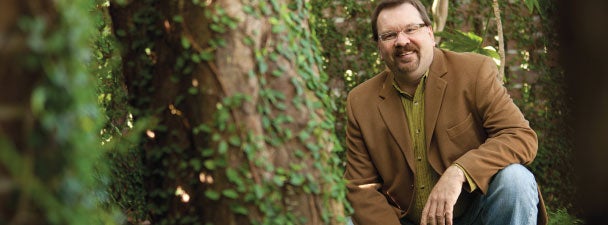In the last decade or so, we’ve mapped the human genome, the genome of the sea urchin and the genome of wild mustard. We’ve also mapped the genomes of the apple, African elephant and eucalyptus tree, not to mention the zebrafish, chicken, opossum, sucking louse, an ancient plague microbe and dozens more organisms. But no scientist, it turns out, had ever bothered to map the genome of a plain, old (non-avian) reptile.
That’s where Andy Shedlock comes in.
The biology professor was part of a team that recently unveiled the genome of the green anole lizard. Their research was published last fall in Nature, which recognized that the scientists’ work filled “a yawning genome-sequence gap in the animal lineage.”
As Shedlock sees it, the mapping of the anole’s genome is part of the exploration of a vast and relatively new frontier in science: genomics. Such a frontier is ripe with possibility, especially in the realm of medicine. But unforeseen complexities have curbed initial expectations of medical breakthroughs. The bottom line is that despite discovering the DNA sequences of many organisms, there is still a lot more to learn about our genes, how they are activated and what is responsible for biological diversity.
Nevertheless, despite current limitations of understanding, scientists believe it is important to map and analyze as many genomes as possible. Fortunately, with improvements in technology, it’s becoming easier and cheaper to do so. Individuals can now buy their own genome map for about $10,000. Soon, it could be less than $1,000.
“If you’re a curious person,” Shedlock says, “it really is a time of great discovery.”
At the College, Shedlock looks forward to teaching curious students. He left a senior research position at Harvard University for the teaching opportunities at the College, as well as the chance to do more work in the realm of one of his early scientific interests: marine biology.
“This was a chance to cut some new turf and get back to my roots,” Shedlock notes. “As I get older, teaching has become more meaningful to me. It’s time to pass the torch.”
One lesson Shedlock aims to impart is the value of the genomics perspective in other biological fields. He mentions the thrills of travel and wildlife observation, and how the wonder associated with these experiences is amplified by an understanding of genetics.
“It becomes really rewarding,” he says. “You understand the subject so much better and you can think what these really important next steps need to be.”
One of Shedlock’s next steps is helping to map the genome of the painted turtle. For this ambitious scientist, it’s a project that can’t get done soon enough.
“We’ve got to sequence this turtle,” says Shedlock. “This is going to be crazy.”
And it’ll be another important step in deciphering the scientific wonders around us.




